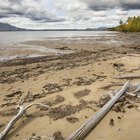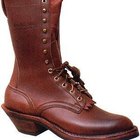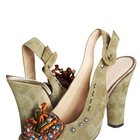
As pioneers and early settlers crossed harsh terrain to settle the West, they usually came with nothing more than a team of oxen or horses and a covered wagon that held all of their worldly possessions. The covered wagon was also their refuge in inclement weather. Unfortunately, the road West was one littered with rivers and creeks, meaning that the pioneers would need to get their animals, possessions and wagon across the river. They would work hard in preparing wagons for river crossings to keep everything and everyone safe.
Bolting Down
When the early settlers viewed a river ahead, they sent out scouts to look for the best place to cross. They would not want to cross somewhere where the water was too deep or especially fast-moving. At times, rivers had areas of undertow called "chutes" that could drown animals, so it was important to look for slow moving water. If you were a pioneer, while the scouts looked for the best place, you'd begin securing your belongings with ropes and rubbing wax all over the open portions of the wagon to help waterproof it against the rushing river. All of the people, even children, were removed from the wagons to get ready to cross on foot or by raft.
Shallow Water
If the water in the river was fairly shallow, the pioneers could drive straight across it with their teams of oxen. In this case, what was too heavy would be removed from the wagons to make it easier for the oxen to pull the heavy wagons across the often rocky riverbeds. As a pioneer, you'd have to go to work in helping your neighbors carry items across the river on foot, and children were usually carried across as well. If the water was shallow, but the wagons too heavy and the water fast, you would ask a neighbor to double-up teams of oxen for each wagon and slowly get everyone's wagons across one at a time.
Deep Water
If the pioneers came across water that was moving too fast or was too deep, and a more shallow place to cross was not found, then they would quickly create rafts that were known as "scows." These lightweight rafts had beams to tie the wagons onto and float them across to the other side. If you were a pioneer, you'd need to remove almost all that you could from your wagon to make it light enough to float with a makeshift raft. One would need to lash fallen trees and rods together with rope to create a scow, and drive posts in it for keeping the wagons in place. Often, when American Indians were present, they would secure leather boats in which to get their belongings across the river.
Related Articles

Types of Flat-Bottomed Boats

Alternate Ways to Divert Roof Rain Water
Fun Things to Do in Oregon With Kids

Beaches in Maine to Find Sea Glass
Things to Do on Vacation With Kids in ...

How to Make a Whale Out of Fondant
Things to Do in Branson With Kids
Things to Do With Kids in Louisville, ...
Things to Do in Las Vegas with Kids

What Games Did Children Play in ...

The Tools Used for Curling Hair in the ...

High Heels in the 1950s

How to: Eucalyptus Oil as a Flea ...

1950s Clothes for Children
Free Things to Do in Monterey
Free Things to Do in Portland

Definition of Packer Boots
5 North Carolina Family Vacation Ideas

How to Clean Suede Shoes With Water
Things to Do With Kids in Tucson
References
Writer Bio
Kay Ireland specializes in health, fitness and lifestyle topics. She is a support worker in the neonatal intensive care and antepartum units of her local hospital and recently became a certified group fitness instructor.